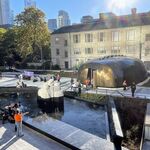A
AlvinofDiaspar
Guest
From the Post:
City mulls private investment in facilities
'Look at all options,' advises budget chief Soknacki
James Cowan, National Post
Published: Tuesday, July 18, 2006
Private money may increasingly pay for Toronto's parks, recreation facilities and public housing as the city struggles to find $2.7-billion for capital projects.
City councillors are debating a capital spending plan for the next five years. Faced with a pressing need to finance everything from new streetcars to recycling programs to waterfront parks, some politicians think it is time to seek out private companies to pay for public infrastructure.
At their meeting later this month, councillors will consider a motion calling for a study of "innovative capital finance strategies," including partnerships with non-profit organizations and private companies. Put forward by Mayor David Miller, the proposal has the support of David Soknacki, the city's budget chief.
According to Mr. Soknacki, Toronto must either find new ways to pay for its basic needs or "reduce the expectations of residents."
"The city has to look at all available options, and that means having discussions with the private sector as well as the public sector," Mr. Soknacki said in an interview. "The public is saying to us, 'Make [services] happen, make it work,' so we need to take a look at a wide range of options while preserving the public interest."
The city arguably lags behind other Canadian municipalities when it comes to partnerships with the private sector. Both Ottawa and Vancouver funded light-rail projects with private money, while cities such as Edmonton and Halifax solicited private investment in their water services. Meanwhile, Toronto has watched as several promising public-private partnerships have collapsed, most notably a deal with the Union Pearson Group to refurbish Union Station.
When business does contribute to Toronto's infrastructure, its participation tends to come as charity. The Franklin Children's Garden on Centre Island, for example, was built using $1-million in city money bolstered by donations from companies such as TD Bank and Unilever.
Featuring an amphitheatre, tree house and 10,000 shrubs, the garden is an early showpiece for the city's 15-year park revitalization project.
But Toronto would have had difficulty financing the project by itself, according to Leslie Coates, the parks department's manager of special projects.
"If you want to go beyond the basics of grass and trees, you have to look elsewhere, because it gets expensive," Ms. Coates said. "When it came to Franklin, I knew that in order to make something spectacular and beyond the everyday, I would probably need other partners."
She noted the Toronto Music Garden on Queen's Quay Boulevard was similarly funded through a combination of tax dollars and private donations. In each case, Ms. Coates said local residents were accepting of the private sector's presence in their public space.
"We were always clear that this is a public park, this is not about privatization," she said. "This is about investment by the business community in a public park space.... If we had gone down a road and said we were going to charge admission to the children's garden, I personally would have had a problem with it."
Mr. Soknacki cites the redevelopment of the Guild Inn site in Scarborough as a solid example of private investment serving the public interest. Once an artists' colony, the inn fell into the hands of the Toronto Regional Conservation Authority in 1978 and has sat empty since 2001. Now, the authority and the city have proposed leasing part of the site to a private developer who would replace the decaying inn with a new $54-million complex. With the revenue from the lease, the city would be able to set up workshops for artists, recreating the feel of the old artists' colony.
"The city will get a structure that will be the pride of eastern Toronto and the funding to provide a cultural precinct that will be a gem," Mr. Soknacki said.
Some question the wisdom of selling -- or even leasing out -- pieces of the public realm. Past experiments with private investment resulted in trash bins and bus shelters with lots of advertising space but serious design flaws, according to Jonathan Goldsbie, a member of the Toronto Public Space Committee.
"The garbage boxes are falling apart, the transit shelters did not have street names on them for four years," Mr. Goldsbie said. "Private investment in infrastructure has never been demonstrated to work properly in Toronto."
The Mayor himself is skeptical about private investment, despite proposing the review of the city's capital financing strategies.
"From my perspective, the circumstances are fairly narrow where it really works," Mr. Miller said. "For the most part, public investment will be the cheapest way to go for investment in public infrastructure. Governments can borrow at a lower cost than private companies, so that's usually the most efficient."
That said, Mr. Miller conceded there are places where partnerships are worth pursuing. He noted Vancouver has been successful in financing public housing by teaming with pension funds.
"It is one option in that needs to be reviewed," the Mayor said.
For his part, Mr. Soknacki said he understands the reluctance of some of his colleagues to explore private investment.
"It's human nature to always want to own things, and council is no different," he said. "However, if you have to carry out a responsibility and don't have the funds for it, I think you will want to look at other opportunities."
jcowan@nationalpost.com
PRIVATE & PUBLIC
Four examples of private money serving the public good in Toronto:
NIKE MALVERN SPORTS COMPLEX
Nike Canada donated $500,000 toward an athletic facility built using recycled running shoes. The complex is located at Mother Teresa Catholic Secondary School in Malvern.
NATIONAL SOCCER STADIUM
The new 20,000-seat stadium at Exhibition Place is a partnership between provincial, federal and municipal governments and Maple Leaf Sports and Entertainment. The company, which owns both the Maple Leafs and Raptors, contributed $8-million and paid an additional $10-million for the building's naming rights, which it intends to sell to another business. Meanwhile, the city will contribute $10-million in money and land, Ontario will give $8-million and Ottawa will supply $27-million. The stadium will host the FIFA junior men's championships in 2007.
FRANKLIN CHILDREN'S GARDEN
The $2-million project was financed through an even split of public and private funds. While the facility remains public, the corporate sponsorship is acknowledged through features such as TD Storybrook Place, Unilever Snail Trail and Kids Can Press Little Sprouts Garden.
MEGABINS
Media company Eucan proposed installing 1,500 of the 2.3-metre-tall garbage cans with illuminated advertising panels across Toronto. The company retained ownership of the cans but provided the city with a portion of its advertising revenue. In exchange, the city was responsible for collecting trash from the bins. Approximately 100 of the bins were put in place as a pilot project last year but the city decided not to expand the program.
© National Post 2006
AoD
City mulls private investment in facilities
'Look at all options,' advises budget chief Soknacki
James Cowan, National Post
Published: Tuesday, July 18, 2006
Private money may increasingly pay for Toronto's parks, recreation facilities and public housing as the city struggles to find $2.7-billion for capital projects.
City councillors are debating a capital spending plan for the next five years. Faced with a pressing need to finance everything from new streetcars to recycling programs to waterfront parks, some politicians think it is time to seek out private companies to pay for public infrastructure.
At their meeting later this month, councillors will consider a motion calling for a study of "innovative capital finance strategies," including partnerships with non-profit organizations and private companies. Put forward by Mayor David Miller, the proposal has the support of David Soknacki, the city's budget chief.
According to Mr. Soknacki, Toronto must either find new ways to pay for its basic needs or "reduce the expectations of residents."
"The city has to look at all available options, and that means having discussions with the private sector as well as the public sector," Mr. Soknacki said in an interview. "The public is saying to us, 'Make [services] happen, make it work,' so we need to take a look at a wide range of options while preserving the public interest."
The city arguably lags behind other Canadian municipalities when it comes to partnerships with the private sector. Both Ottawa and Vancouver funded light-rail projects with private money, while cities such as Edmonton and Halifax solicited private investment in their water services. Meanwhile, Toronto has watched as several promising public-private partnerships have collapsed, most notably a deal with the Union Pearson Group to refurbish Union Station.
When business does contribute to Toronto's infrastructure, its participation tends to come as charity. The Franklin Children's Garden on Centre Island, for example, was built using $1-million in city money bolstered by donations from companies such as TD Bank and Unilever.
Featuring an amphitheatre, tree house and 10,000 shrubs, the garden is an early showpiece for the city's 15-year park revitalization project.
But Toronto would have had difficulty financing the project by itself, according to Leslie Coates, the parks department's manager of special projects.
"If you want to go beyond the basics of grass and trees, you have to look elsewhere, because it gets expensive," Ms. Coates said. "When it came to Franklin, I knew that in order to make something spectacular and beyond the everyday, I would probably need other partners."
She noted the Toronto Music Garden on Queen's Quay Boulevard was similarly funded through a combination of tax dollars and private donations. In each case, Ms. Coates said local residents were accepting of the private sector's presence in their public space.
"We were always clear that this is a public park, this is not about privatization," she said. "This is about investment by the business community in a public park space.... If we had gone down a road and said we were going to charge admission to the children's garden, I personally would have had a problem with it."
Mr. Soknacki cites the redevelopment of the Guild Inn site in Scarborough as a solid example of private investment serving the public interest. Once an artists' colony, the inn fell into the hands of the Toronto Regional Conservation Authority in 1978 and has sat empty since 2001. Now, the authority and the city have proposed leasing part of the site to a private developer who would replace the decaying inn with a new $54-million complex. With the revenue from the lease, the city would be able to set up workshops for artists, recreating the feel of the old artists' colony.
"The city will get a structure that will be the pride of eastern Toronto and the funding to provide a cultural precinct that will be a gem," Mr. Soknacki said.
Some question the wisdom of selling -- or even leasing out -- pieces of the public realm. Past experiments with private investment resulted in trash bins and bus shelters with lots of advertising space but serious design flaws, according to Jonathan Goldsbie, a member of the Toronto Public Space Committee.
"The garbage boxes are falling apart, the transit shelters did not have street names on them for four years," Mr. Goldsbie said. "Private investment in infrastructure has never been demonstrated to work properly in Toronto."
The Mayor himself is skeptical about private investment, despite proposing the review of the city's capital financing strategies.
"From my perspective, the circumstances are fairly narrow where it really works," Mr. Miller said. "For the most part, public investment will be the cheapest way to go for investment in public infrastructure. Governments can borrow at a lower cost than private companies, so that's usually the most efficient."
That said, Mr. Miller conceded there are places where partnerships are worth pursuing. He noted Vancouver has been successful in financing public housing by teaming with pension funds.
"It is one option in that needs to be reviewed," the Mayor said.
For his part, Mr. Soknacki said he understands the reluctance of some of his colleagues to explore private investment.
"It's human nature to always want to own things, and council is no different," he said. "However, if you have to carry out a responsibility and don't have the funds for it, I think you will want to look at other opportunities."
jcowan@nationalpost.com
PRIVATE & PUBLIC
Four examples of private money serving the public good in Toronto:
NIKE MALVERN SPORTS COMPLEX
Nike Canada donated $500,000 toward an athletic facility built using recycled running shoes. The complex is located at Mother Teresa Catholic Secondary School in Malvern.
NATIONAL SOCCER STADIUM
The new 20,000-seat stadium at Exhibition Place is a partnership between provincial, federal and municipal governments and Maple Leaf Sports and Entertainment. The company, which owns both the Maple Leafs and Raptors, contributed $8-million and paid an additional $10-million for the building's naming rights, which it intends to sell to another business. Meanwhile, the city will contribute $10-million in money and land, Ontario will give $8-million and Ottawa will supply $27-million. The stadium will host the FIFA junior men's championships in 2007.
FRANKLIN CHILDREN'S GARDEN
The $2-million project was financed through an even split of public and private funds. While the facility remains public, the corporate sponsorship is acknowledged through features such as TD Storybrook Place, Unilever Snail Trail and Kids Can Press Little Sprouts Garden.
MEGABINS
Media company Eucan proposed installing 1,500 of the 2.3-metre-tall garbage cans with illuminated advertising panels across Toronto. The company retained ownership of the cans but provided the city with a portion of its advertising revenue. In exchange, the city was responsible for collecting trash from the bins. Approximately 100 of the bins were put in place as a pilot project last year but the city decided not to expand the program.
© National Post 2006
AoD




